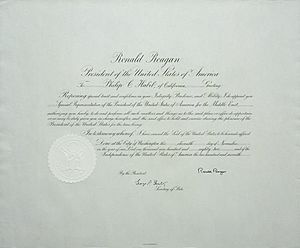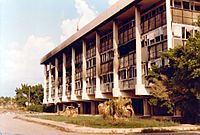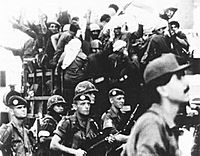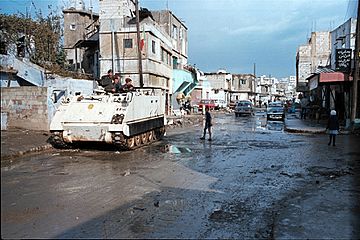Multinational Force in Lebanon facts for kids
Quick facts for kids Multinational Force Beirut – Lebanon |
|
|---|---|
| Force multinationale de sécurité à Beyrouth (French) Forza Multinazionale in Libano (Italian) |
|
|
Clockwise from top left: United States Navy LARC-V landing in Beirut, September 1982; Lebanese Army in Beirut, 1982; Italian President Sandro Pertini in Lebanon during a visit to the Italian contingent in 1983; PLO office in Sidon, 1982; Fighter jet taking off from French aircraft carrier Foch off the coast of Lebanon, 1983; French Aérospatiale SA 330 Puma helicopters in Beirut, Lebanon, 1983; USMC Bell AH-1T SeaCobra helicopter on patrol outside the city of Beirut, May 1983; U.S. Marines on patrol in Beirut, April 1983; Israeli troops in Sidon, August 1982; Green Line, Beirut 1982
|
|
| Active | Aug. 25, 1982 – Mar. 31, 1984 |
| Countries | |
| Role | Peacekeeping mission Interposition force |
| Garrison/HQ | Beirut, Lebanon |
| Engagements | Lebanese Civil War |
| Disbanded | March 1984 |
| Commanders | |
| USMNF (Task Force 62) (Aug 82-Feb 84) |
Col. James M. Mead 32nd MAU (Aug–Oct 82) Col. Thomas M. Stokes, Jr. 22nd MAU (Nov 83 – Feb 84) |
| British Forces (Feb 83-Feb 84) |
Lt. Col. John de P. Ferguson 1st The Queen's Dragoon Guards (Sep 83 – Jan 84) |
| French Forces (Aug 82 – Mar 84) |
11th Airborne Division, B. Gen. Jacques Granger (Aug–Sep 82) 11th Airborne Division, B. Gen. Jacques Granger (Sep 82 – Jan 83) |
| Italian Forces (Aug 82-Jan 84) |
Paratroopers Brigade Folgore and San Marco Battalion, B. Gen. Franco Angioni (Aug 82 – Jan 84) |
| Insignia | |
| Patches | |
The Multinational Force in Lebanon (MNF) was a group of soldiers from different countries. They were sent to Lebanon in August 1982. Their main job was to help keep the peace during the Lebanese Civil War. This war involved many groups, including the Palestine Liberation Organization (PLO) and Syria.
Before the MNF arrived, there was a ceasefire between the PLO and Israel. But this peace broke down in June 1982 when Israel invaded Lebanon. The city of Beirut was surrounded for seven weeks. Finally, the PLO agreed to leave. The MNF was then created to help the Lebanese Armed Forces make sure the PLO, Syrian forces, and other foreign fighters left peacefully.
The MNF included soldiers from the United States, France, Italy, and the United Kingdom. At first, they were seen as peacekeepers. But as the civil war got worse, some groups started to see them as taking sides. After a terrible bombing in October 1983 that killed many American and French soldiers, the MNF began to leave. They fully left Lebanon by July 1984. The United Nations Interim Force in Lebanon (UNIFIL) then took over the peacekeeping role.
Contents
- What Was the MNF's Mission?
- Who Was Part of the MNF?
- A Look Back at History
- Evacuating Forces: Beirut I
- Operation DIODON: French Efforts
- Italcon Mission: Italian Contributions
- BRITFORLEB: British Support
- Return to Beirut: Beirut II
- Training and Patrols: Beirut III & IV
- Escalating Conflict: Beirut V
- The Barracks Bombing
- Changes and Withdrawal: Beirut VI
- Casualties
- See also
What Was the MNF's Mission?
The main goal of the Multinational Force was to help bring peace and stability to Lebanon. They wanted to make sure all foreign armies left the country. They also helped to train the Lebanese Armed Forces. This was to help the Lebanese government regain control over Beirut and unite the country.
The MNF's job was to be a neutral force. They were there to keep different groups apart. They were not supposed to fight, but they could defend themselves if attacked.
The MNF (multinational force) is to provide an interposition force at agreed locations and thereby provide the MNF presence requested by the Government of Lebanon to assist it and Lebanon's armed forces in the Beirut area. This presence will facilitate the restoration of Lebanese Government sovereignty and authority over the Beirut area and thereby further its efforts to assure the safety of persons in the area and to bring to an end the violence which has tragically recurred.
Who Was Part of the MNF?
The MNF was made up of soldiers from four countries. Each country had specific tasks:
- United States: About 1,400 U.S. Marines were stationed at Beirut International Airport. They also helped protect U.S. diplomatic buildings.
- Italy: Around 1,400 Italian soldiers, including paratroopers and Marines, were in southwest Beirut. They also helped protect refugee camps like Sabra and Shatila.
- France: French soldiers, including paratroopers, were based near the port of Beirut. They had about 1,600 troops.
- United Kingdom: A small group of about 100 British soldiers with armored cars were initially east of Beirut International Airport. They later moved offshore.
Each country also had naval ships or air support in the area.
A Look Back at History


This wasn't the first time the U.S. was involved in Lebanon. In 1958, the U.S. sent Marines to Lebanon. This was to help the Lebanese government during a time of unrest. President Dwight D. Eisenhower sent 14,000 U.S. troops to prevent the country from falling into chaos. They left after a new president was peacefully chosen.
In April 1975, the Lebanese Civil War began. This was sparked by fighting between different groups. In June 1982, Israel invaded Lebanon. They targeted PLO bases in Beirut.
As Beirut was under siege, U.S. special envoy Philip Habib worked to find a solution. He helped create an agreement for Syrian and PLO fighters to leave Beirut. This agreement also led to the first deployment of the Multinational Force.
Evacuating Forces: Beirut I
The first MNF troops arrived in Beirut in August 1982. French soldiers landed on August 21. U.S. Marines arrived on August 25. Italian soldiers came on August 26. This first group had about 850 U.S., 860 French, and 575 Italian troops. Their job was to secure Beirut's port. This was where the PLO fighters would leave by ship.
The evacuation went smoothly for 15 days. PLO chairman, Yasser Arafat, left on August 30. He was escorted by French forces. After the evacuation was complete, the MNF troops left Beirut on September 9. They returned to their ships in the Mediterranean Sea.
Operation DIODON: French Efforts

French forces, including paratroopers, played a big role. They helped with the PLO evacuation in August 1982. After the Sabra and Shatila massacre, more international forces were sent. French units continued to work in Beirut. Their mission was to mediate and keep the peace. They helped secure the area and build trust. The last French troops involved in Operation DIODON left Lebanon in September 1983.
Italcon Mission: Italian Contributions
The Italian Contingent (Italcon) had about 2,300 soldiers. They arrived in Beirut on September 24, 1982. This group included paratroopers, infantry, and Marines. They also had a military medical team. The Italians were responsible for the southern part of the city. This area was near the refugee camps of Sabra, Shatila, and Burj al Barahinah.
BRITFORLEB: British Support
The United Kingdom joined the MNF on December 15, 1982. Prime Minister Margaret Thatcher was careful about getting involved. But she agreed to send a small force to support the U.S. The British contingent, called Operation Hyperion, was a small armored reconnaissance unit. It had about 100-115 soldiers. They were based in East Beirut. The British forces did not suffer any deaths. They left with the other MNF contingents in February 1984.
Return to Beirut: Beirut II
After Lebanese President-elect Bachir Gemayel was killed on September 14, 1982, the situation got worse. Israeli troops entered West Beirut. They allowed a Christian militia to enter refugee camps. This led to the terrible Sabra and Shatila massacre. Hundreds of Palestinian refugees were killed.
This event made U.S. President Ronald Reagan organize a new MNF. This new force, with about 1,200 troops, entered Beirut on September 29. Their goal was to help the new Lebanese government and army bring stability.
The U.S. Marines set up their headquarters at Beirut International Airport. French paratroopers were near the port. Italian troops were in the southern part of the city, near the refugee camps. In February 1983, British armored cars also joined the MNF.
Training and Patrols: Beirut III & IV
In November 1982, U.S. Marines began training the Lebanese Armed Forces (LAF). They taught them individual and small unit skills. The MNF was successful in its mission during the winter of 1982–1983. They helped prevent attacks from different Lebanese groups and the Israeli Army. They patrolled Beirut to gather information and show their commitment to peace.
On April 18, 1983, the U.S. embassy in West Beirut was bombed. This attack killed 63 people. A terrorist drove a van full of explosives into the embassy lobby. This was a clear sign that some groups did not want the MNF there. French Marines quickly responded to help with rescue efforts.
In the summer of 1983, U.S. Marines at the airport faced repeated attacks. They were shelled by Shia and Druze militias. Several Marines were killed or wounded. U.S. warships offshore fired back at the militia positions.
Escalating Conflict: Beirut V
The security situation in Beirut got worse in the summer of 1983. Fighting increased between different Lebanese groups. The airport was shelled, wounding U.S. Marines and closing the airport temporarily.
The MNF positions at the airport came under more fire. On August 29, 1983, the U.S. Marines fired back for the first time. Two Marines were killed in a mortar attack. As the fighting continued, the MNF was seen less as a neutral force. This was especially true after they directly supported the Lebanese Army in some battles.
The Barracks Bombing

The MNF suffered its worst attack on October 23, 1983. Terrorists drove two truck bombs into the U.S. and French barracks. These were simultaneous attacks. The bombs were huge, equal to six tons of TNT. The U.S. barracks building was ripped from its foundation and collapsed.
This attack killed 241 U.S. servicemen and 58 French paratroopers. The FBI called it the largest non-nuclear explosion they had ever seen.
After this terrible event, people in the U.S. began to question why the MNF was in Lebanon. Calls to withdraw the troops grew louder. However, President Reagan initially said he would keep the troops there.
Changes and Withdrawal: Beirut VI
After the bombing, efforts were made to improve the safety of the troops. New bunkers were built, and positions were made stronger. The goal was to prevent more terrorist attacks.
Tensions also rose between Syria and the United States. Syrian anti-aircraft batteries fired on U.S. aircraft patrolling Lebanese airspace. On December 4, U.S. aircraft targeted Syrian missile batteries. Two American planes were shot down. One pilot was killed, and another was captured.
On the same day, eight U.S. Marines were killed when Syrian-backed militias shelled an observation post. The battleship USS New Jersey fired its large guns at Syrian and Druze positions in response.
By early 1984, the situation was very unstable. The Lebanese Prime Minister and his cabinet resigned. Fighting broke out in Beirut. President Reagan ordered the U.S. Marines to begin withdrawing on February 7.
The Italians left on February 20. The main group of U.S. Marines left on February 26. A small group of Marines stayed to protect the U.S. Embassy until July 31. The last French troops left on March 31, 1984. The collapse of the Lebanese army was a key reason for the MNF's withdrawal.
Casualties
The Multinational Force suffered significant losses during its mission.
- United States: 265 U.S. servicemen died in Lebanon. 241 of them were killed in the barracks bombing. 159 were wounded.
- France: France lost over 89 soldiers. 58 French paratroopers died in the barracks bombing. Other French soldiers were killed during combat operations, demining, and training.
- Italy: The Italian forces lost two soldiers, both due to hostile actions.
See also
 In Spanish: Fuerza Multinacional en el L%C3%ADbano para ni%C3%B1os
In Spanish: Fuerza Multinacional en el L%C3%ADbano para ni%C3%B1os
















